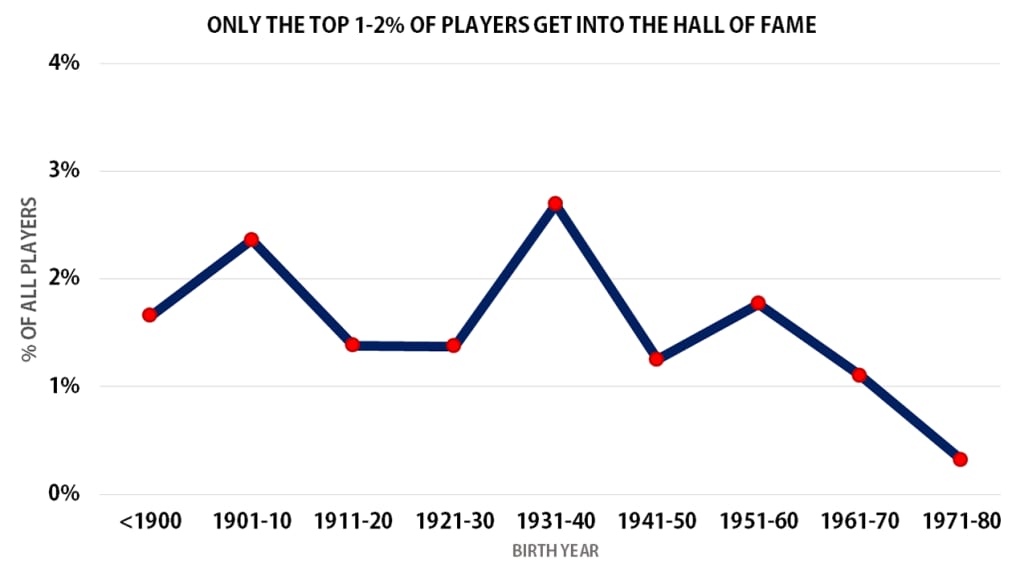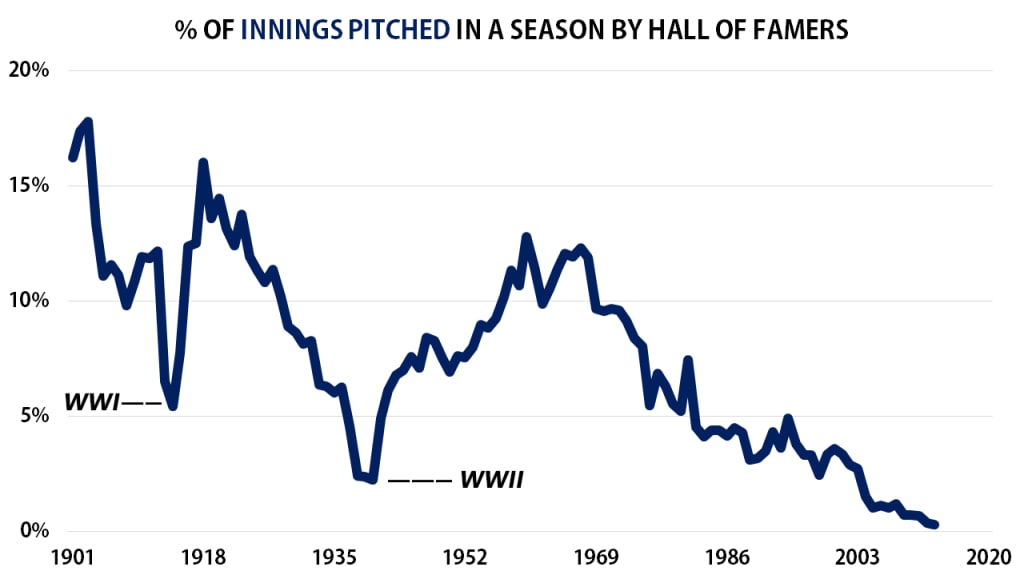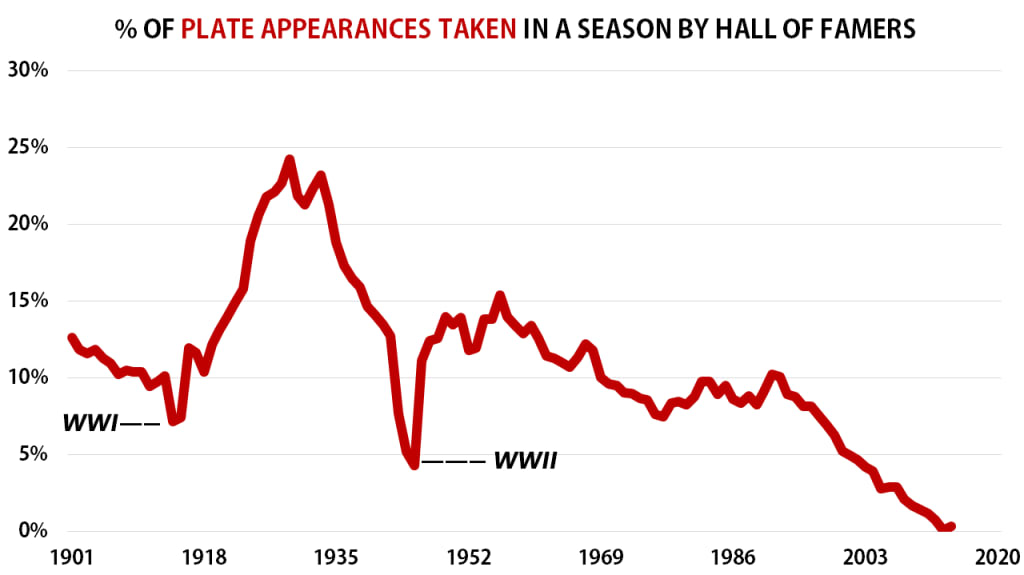With the release of the 2021 Hall of Fame ballot earlier this month, our thoughts turned to the institution of the Hall itself, and particularly this question: Are enough players being inducted? Or too many? What is the right number of players to have in the Hall, anyway?
There isn't a correct answer to that, of course. Maybe you're a "Big Hall" person, or maybe you like it to be far more selective. Either approach is fine, but without knowing the historic trends of what share of active players at a given time end up getting in, we're sort of shooting in the dark. If we look back through history, we can see if more recent players are getting in at a higher or lower rate -- which might help us answer whether more or fewer players should be inducted.
There are a few ways to look at this, but to start, we'll take a study that Dave Cameron (then writing for FanGraphs, now special assistant to the GM for the Padres) wrote back in 2013 and updated it seven years later. What Cameron did was to look at Hall of Famers split into decades by birth year, pointing out that, at the time, only two players born after 1960 had been inducted (Roberto Alomar and Barry Larkin). While the definition of a decade is somewhat arbitrary, for consistency's sake, we'll stick with doing it in the "1961-70" fashion, not "1960-69."
We'll update that with seven more years, fix what appears to be a minor mathematical issue with the 2013 study, and we'll come up with this:

Looking at it like this, 1.5% of all players who have ever played -- that's 1.8% of hitters and 1.1% of pitchers -- have entered the Hall of Fame. If you think eternal enshrinement should be reserved for the absolute best of the best, then maybe the top 1 percent or so sounds right. It's certainly an easy number to define as "the cream of the crop," anyway.
You'll also notice a slight downward trend. We'll get back to that.
Comparing this to when Cameron did his work in 2013, we've since seen an additional 15 Hall of Famers who were born between 1961-70, and six more, to date, from 1971-80. That's partially due to the passage of time -- Mariano Rivera, born in 1969 and inducted unanimously in 2019, had only just completed his final season in '13 -- and partially because the writers have alleviated a logjam that came to a head when zero players were inducted in '13. (Thirteen have gone in over the last four years.) It remains possible that the 1960s get another bump this year if Omar Vizquel (born '67) and Curt Schilling (born '66) -- who appear to be the two most likely candidates this year -- are inducted.
That aside, we've set a baseline: 1.5% of all players get into Cooperstown. But let's try this another way, because maybe just looking at the share of Hall of Famers out of "all players" gets skewed over time, as the sheer number of players (mostly pitchers) keeps on skyrocketing, while their share of playing time decreases. (To cherry pick but one example, the 1961 Yankees, in the first year of the 162-game schedule, used 36 players ... while the 2019 Yankees used 54.)
Instead, let's try to look at Hall of Famers out of "regular" players, which we'll somewhat arbitrarily define as hitters who received 1,000 career plate appearances and pitchers who threw at least 500 innings. You might prefer to set those numbers higher, but mostly we're trying to exclude the cup-of-coffee guys, and these numbers are about two full seasons of hitting and two to three full seasons of starting pitching or six to seven of relieving. More important, the number of players who reached those thresholds is about one-third of all players who ever appeared, which gives us a nice clean line of "semi-regular, successful ballplayers."

That sets the number a little higher, so instead of saying "1.5% of all players make it to Cooperstown," you could also say "4.3% of all regular players make it there," again, assuming you're using our definition of "regular."
The shape is consistent, as both views have a bump in the players who were born from 1931-40, the "Golden Age" stars of the 1950s and '60s. You might like to think that's because the era of Mantle, Mays, and Koufax simply had that many great players; it might also be because that particular era of baseball, through media, myth and legend, seems to have taken on an outsize importance. (It is probably during the youth of a great deal of today's voting sportswriters.)
But more important than the shape, there is the downward slope, which is offering an unavoidable truth -- it's become more difficult than ever to get into Cooperstown, and that's not likely to change in the near future.
Take, for example, the six players we noted who were born in the 1970s who have made it into the Hall so far -- Pedro Martínez, Iván Rodríguez, Chipper Jones, Derek Jeter, Vladimir Guerrero and Roy Halladay. That's a mere 0.9% of regular players, and just 0.3% of all players from that decade.
Now, the story of that decade hasn't been fully written yet. These additional four have strong-to-no-question odds of joining them, and remember that 1980 births are included in our 1971-80 decade:
• Ichiro Suzuki (born in 1973, eligible following the 2024 season)
• Albert Pujols (born Jan. 16, 1980, still active)
• Adrián Beltré (born in 1979, eligible after 2023)
• CC Sabathia (born in 1980, eligible after 2023)
Perhaps they'll be joined by Todd Helton (born 1973) or David Ortiz ('75) or Álex Rodríguez ('75) or Andruw Jones ('77) or Carlos Beltrán ('77) or Chase Utley ('78), but also, perhaps not. If they're not, if it's just these four, then we'll end up with just 10 Hall of Famers born in the '70s. It would be by far the fewest from any decade in the 20th century, and, it would mean that in order to get up to historic averages, the Hall would be something like 18 players short from the decade.
Let's find another way to look at this. Rather than decades and careers, let's look at the percentage of innings pitched by future Hall of Famers in a season ...

... and the same thing again, this time from the hitting side, showing percentage of plate appearances taken by future Hall of Famers.

You should have two takeaways from these:
1) The lowest points in the first nine decades or so of the 21st century came during the two World Wars, understandably so. Bob Feller, for example, missed all of 1942-44 in America's service, while Ted Williams missed all of 1943-45. Dozens of Hall of Famers missed the primes of their careers serving, plus several more (including Williams again) in the Korean War. The talent level had a meaningful drop.
2) The last three decades have consistently had the lowest Hall of Famers-per-year numbers in history outside of those wars, and it's not just because not all of those players are eligible yet.
Taken all together, it does appear we're being too stringent with the recent decades. We're not hitting the "1.5% of all players" or "4.3% of regular players" thresholds, and the only times in history we've seen such a low percentage of Hall of Famers was literally during two world wars.
So: Where are the missing players, the extra few dozen we should have seen who were born since 1960? We can give you three theories as to what's going on here.
PEDs, or suspicions thereof. This is unavoidable, obviously. Barry Bonds (born 1964), Roger Clemens (born '62), and Manny Ramírez (born '72) would all have been inducted on the first ballot if not for the questions surrounding PEDs, and we'll soon have another round of this discussion when Rodríguez (born '75) is eligible one year from now. It's safe to say that this is a much more complicated conversation than we can satisfy here, other than to point out we'll never, ever have a full list of who was using what, and that we know for sure that some already-inducted stars -- even some from the "Golden Age" -- were using some helpers, too.
The 10-player limit. Voters are limited to choosing only 10 names at most on their ballot, which in recent years simply hasn't been enough. There have been several ballots in recent years in which 16 or 17 names were worthy of consideration, and it's likely that some of the slam-dunk candidates at the top lost some support so that voters could select someone who needed the vote more urgently. This has never really made sense; anyone who makes the ballot in the first place has had a great career, and deserves the respect of a yes/no vote, not one that depends on who else happens to be eligible at the time. This may have prevented some good first-year candidates, who were perhaps the 11th-best players on that ballot, from getting serious consideration or possible induction.
A perfect example of this phenomenon is Johan Santana, arguably the best pitcher in baseball over a five-year stretch that included two Cy Young Awards and three top-five finishes. He had the misfortune of appearing on the ballot for the first time in 2018, when four players were inducted (Guerrero, Jones, Jim Thome and Trevor Hoffman) and five others got at least 50% of the votes. Santana got only 2.4% of the vote -- below the 5% threshold to stay on the ballot -- and was one and done, as they say, despite the fact that he was legitimately one of the best pitchers of his era. Of course that brings us to our next point ...
No one knows what to do with starting pitchers anymore. Thanks to the way the game has changed, the counting stats compiled by today's greatest starters will never, ever match up to their historic ancestors. To pick but one example: Clayton Kershaw, who should be a no-doubter inductee when he becomes eligible, has 25 complete games and 15 shutouts over his career. Bob Gibson, inducted in 1981, had 28 complete games and 13 shutouts ... in 1968 alone.
With the long-magical 300-win barrier no longer in play, what we've seen is that starting pitchers have generally been ignored. Or, to put that another way, only two pitchers born in the past 50 years have been inducted, and one, Pedro Martínez, has a credible claim to make toward being the best pitcher of all time. (The other, Halladay, made it in on the first ballot, sadly after his passing in a 2017 plane crash.) Schilling, this year, and Sabathia, soon, seem possible to join them.
This part will change eventually, because it has to. Kershaw's guaranteed to get in, and Justin Verlander, Max Scherzer and possibly Zack Greinke have strong chances to join him. Voters are just going to have to get used to not comparing wins or innings totals to pitchers of years past.
But we leave you with this, which might tell the entire story. There are 235 players in the Hall of Fame, currently, with birth dates ranging from 1847 (Deacon White) to 1977 (Halladay). Of those 235, just 55 were born since the end of World War II in 1945. One hundred and eighty seven, or slightly more than 76% of all Hall of Famers, were born before that (thanks, in part, we admit, to some long-ago cronyism on the Veterans Committee).
Meanwhile, there have been 221,495 games in Major League history. A little more than 65% of those games have taken place since the end of 1945. It seems to us that the writers have held a standard in recent decades that's maybe just a bit too high.
